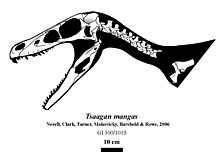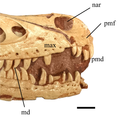ツァーガン
| ツァーガン | |||||||||||||||||||||||||||||||||||||||||||||
|---|---|---|---|---|---|---|---|---|---|---|---|---|---|---|---|---|---|---|---|---|---|---|---|---|---|---|---|---|---|---|---|---|---|---|---|---|---|---|---|---|---|---|---|---|---|
 ホロタイプ
| |||||||||||||||||||||||||||||||||||||||||||||
| 地質時代 | |||||||||||||||||||||||||||||||||||||||||||||
| 白亜紀後期 | |||||||||||||||||||||||||||||||||||||||||||||
| 分類 | |||||||||||||||||||||||||||||||||||||||||||||
| |||||||||||||||||||||||||||||||||||||||||||||
| 学名 | |||||||||||||||||||||||||||||||||||||||||||||
| Tsaagan Norell et al., 2006 | |||||||||||||||||||||||||||||||||||||||||||||
| 種 | |||||||||||||||||||||||||||||||||||||||||||||
|
ツァーガン(Tsaagan)は白亜紀後期に現在のモンゴルに生息していたドロマエオサウルス科の獣脚類恐竜の属の一つである[1]。
発見と命名
[編集]
ホロタイプ標本は1996年に発見され、ヴェロキラプトルと同定された。1998年のコンピュータ断層撮影の結果新たな属であると結論づけられ、2006年12月に記載された[2]。
Tsaagan mangasは属名が種小名を修飾する形になっている為全体として読む必要があり[2]、学名は全体で「白き怪物」を意味する[2][3][4]。属名は白を意味するTsagaanのスペルミス。
現在知られている唯一の標本であるホロタイプ標本IGM 100/1015は成体のもので、保存状態の良好な頭骨と一連の10個の頸椎、損傷した左肩帯から構成される[2]。
形態
[編集]
推定全長約2m[3][4][5]、体高約70cm[4]、体重約15kg[4][5]。
固有派生形質として後耳骨(paroccipital processes)と基翼状骨(basipterygoid)が長いことと、鱗状骨に接触する頬骨が挙げられる[2]。
他のドロマエオサウルス類と同様に、後肢第二趾にシックルクローを持っていた可能性がある[4]。
生態
[編集]他のドロマエオサウルス類と同様に肉食性で狩りを行っていたとされ、他の小型恐竜やトカゲや哺乳類などの小型脊椎動物を捕食していたと考えられる[3]。
分類
[編集]
ツァーガンはドロマエオサウルス科のヴェロキラプトル亜科に含まれる[2][3][6]。
リンヘラプトルと密接な関係にあり[3][7][8][9][10]、Senter (2011)や Turner, Makovicky and Norell (2012)ではリンヘラプトルはツァーガンのシノニムであると主張している[11][12]。 一方、Xu, Pittmanらはリンヘラプトルの解剖学的解析からツァーガンとリンへラプトルは同一の存在ではないとした[13]。
以下は23分類群に114の特徴を使用した、LongrichとCurrieによる系統解析に基づくクラドグラム(2009)[14]。
| 真ドロマエオサウルス類 |
| |||||||||||||||||||||||||||||||||||||||||||||||||||||||||
111分類群に474の特徴を使用した、Turnerらによる系統解析に基づくクラドグラム(2012)[12]。
| 真ドロマエオサウルス類 |
| ||||||||||||||||||||||||||||||||||||
以下はCurrieとEvansによるクラドグラム(2019)[15]。
| 真ドロマエオサウルス類 |
| |||||||||||||||||||||||||||||||||||||||||||||||||||||||||||||||||||||||||||||||||
ディネオベラトルの記載の際にJasinski らによって行われた系統解析に基づくクラドグラム(2020)[16]。
| 真ドロマエオサウルス類 |
| ||||||||||||||||||||||||||||||||||||||||||||||||||||||||||||||||||
古環境
[編集]ツァーガンは孤立した歯を除きUkhaa Tolgod地域から知られる唯一のドロマエオサウルス類であるが、同じジャドフタ層では他のドロマエオサウルス類としてヴェロキラプトルが知られる。
ツァーガンと共存していた可能性のある動物は、プロトケラトプス、シュヴウイア、小型哺乳類のザランブダレステスとクリプトバータル、数種のトカゲ、未記載のトロオドン科とドロマエオサウルス科の2種が挙げられる[2]。
ギャラリー
[編集]-
ホロタイプ標本の吻部
-
頭部の復元
-
頭部の復元
脚注
[編集]- ^ 『学研の図鑑LIVE(ライブ) 恐竜 新版』学研、2022年6月23日、89頁。ISBN 978-4-05-205184-5。
- ^ a b c d e f g Norell, M.A.; Clark, J.M.; Turner, A.H.; Makovicky, P.J.; Barsbold, R.; Rowe, T. (2006). “A new dromaeosaurid theropod from Ukhaa Tolgod (Ömnögov, Mongolia)”. American Museum Novitates (3545): 1–51. doi:10.1206/0003-0082(2006)3545[1:ANDTFU]2.0.CO;2. hdl:2246/5823.
- ^ a b c d e “Tsaagan”. www.prehistoric-wildlife.com. 2023年3月17日閲覧。
- ^ a b c d e “Tsaagan mangas - Beschreibung, Dinodata.de”. dinodata.de. 2023年3月21日閲覧。
- ^ a b Paul, G.S., 2010, The Princeton Field Guide to Dinosaurs, Princeton University Press p. 137
- ^ “Fossilworks: Tsaagan”. www.fossilworks.org. 2023年3月18日閲覧。
- ^ “Linheraptor”. www.prehistoric-wildlife.com. 2023年3月17日閲覧。
- ^ Xu, X., Choinere, J., Pittman, M., Tan, Q., Xiao, D., Li, Z., Tan, L., Clark, J., Norell, M., Hone, D.W.E. and Sullivan, C. (19 March 2010). “A new dromaeosaurid (Dinosauria: Theropoda) from the Upper Cretaceous Wulansuhai Formation of Inner Mongolia, China”. Zootaxa (2403): 1–9 2010年3月19日閲覧。.
- ^ Press, Europa (2010年3月19日). “Descubren una nueva especie de dinosaurio de la familia del velocirraptor”. www.europapress.es. 2023年3月19日閲覧。
- ^ “Students discover new species of raptor dinosaur in Inner Mongolia” (英語). ScienceDaily. 2023年3月21日閲覧。
- ^ Senter, Phil (2011). “Using creation science to demonstrate evolution 2: morphological continuity within Dinosauria (supporting information)”. Journal of Evolutionary Biology 24 (10): 2197–2216. doi:10.1111/j.1420-9101.2011.02349.x. PMID 21726330.
- ^ a b Alan H. Turner, Peter J. Makovicky and Mark Norell (2012). “A review of dromaeosaurid systematics and paravian phylogeny”. Bulletin of the American Museum of Natural History 371: 1–206. doi:10.1206/748.1.
- ^ Xu Xing; Michael Pittman; Corwin Sullivan; Jonah N. Choiniere; Qing Wei Tan; James M. Clark; Mark A. Norell; Wang Shuo (2015). “The taxonomic status of the Late Cretaceous dromaeosaurid Linheraptor exquisitus and its implications for dromaeosaurid systematics”. Vertebrata PalAsiatica 53 (1): 29–62.
- ^ Longrich, N. R.; Currie, P. J. (2009). “A microraptorine (Dinosauria–Dromaeosauridae) from the Late Cretaceous of North America”. Proceedings of the National Academy of Sciences 106 (13): 5002−5007. doi:10.1073/pnas.0811664106.
- ^ Currie, P. J.; Evans, D. C. (2019). “Cranial Anatomy of New Specimens of Saurornitholestes langstoni (Dinosauria, Theropoda, Dromaeosauridae) from the Dinosaur Park Formation (Campanian) of Alberta”. The Anatomical Record 303 (4): 691–715. doi:10.1002/ar.24241. PMID 31497925.
- ^ Jasinski, S. E.; Sullivan, R. M.; Dodson, P. (2020). “New Dromaeosaurid Dinosaur (Theropoda, Dromaeosauridae) from New Mexico and Biodiversity of Dromaeosaurids at the end of the Cretaceous”. Scientific Reports 10 (1). doi:10.1038/s41598-020-61480-7. ISSN 2045-2322.



